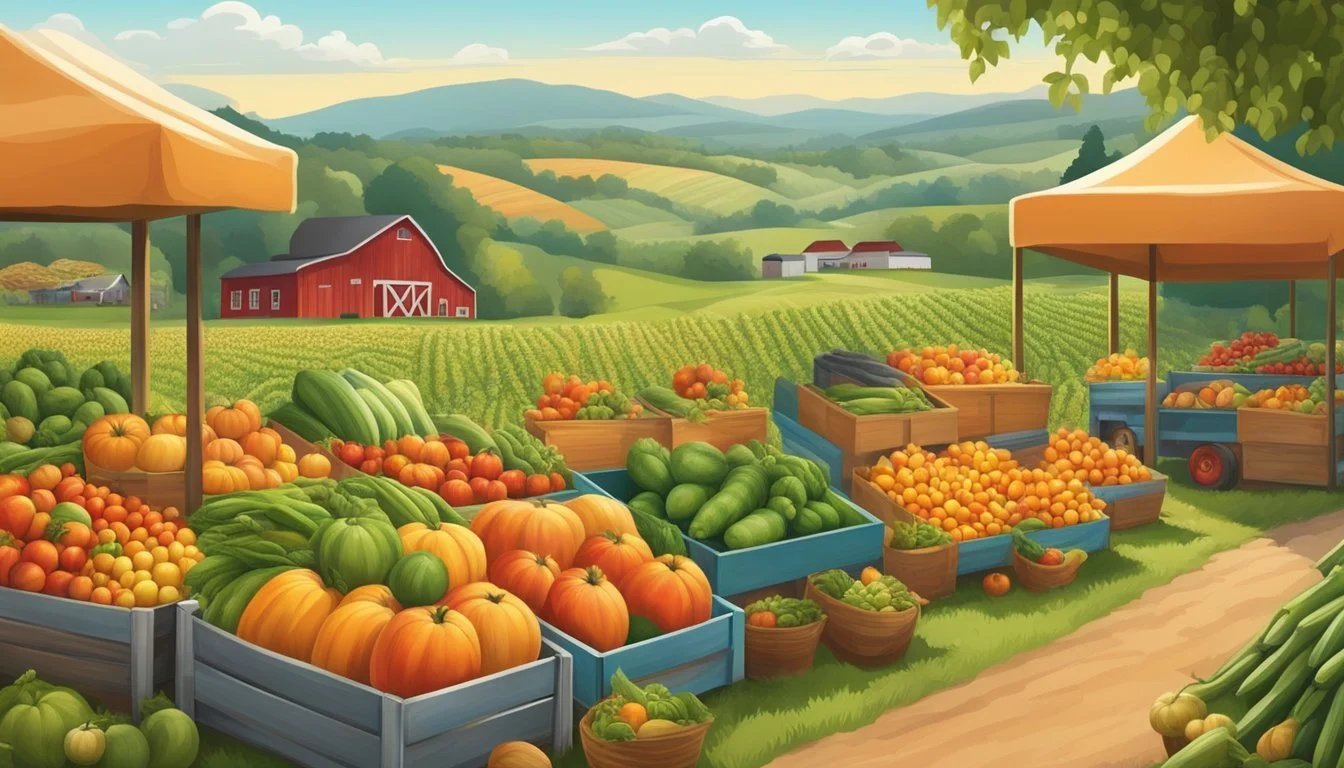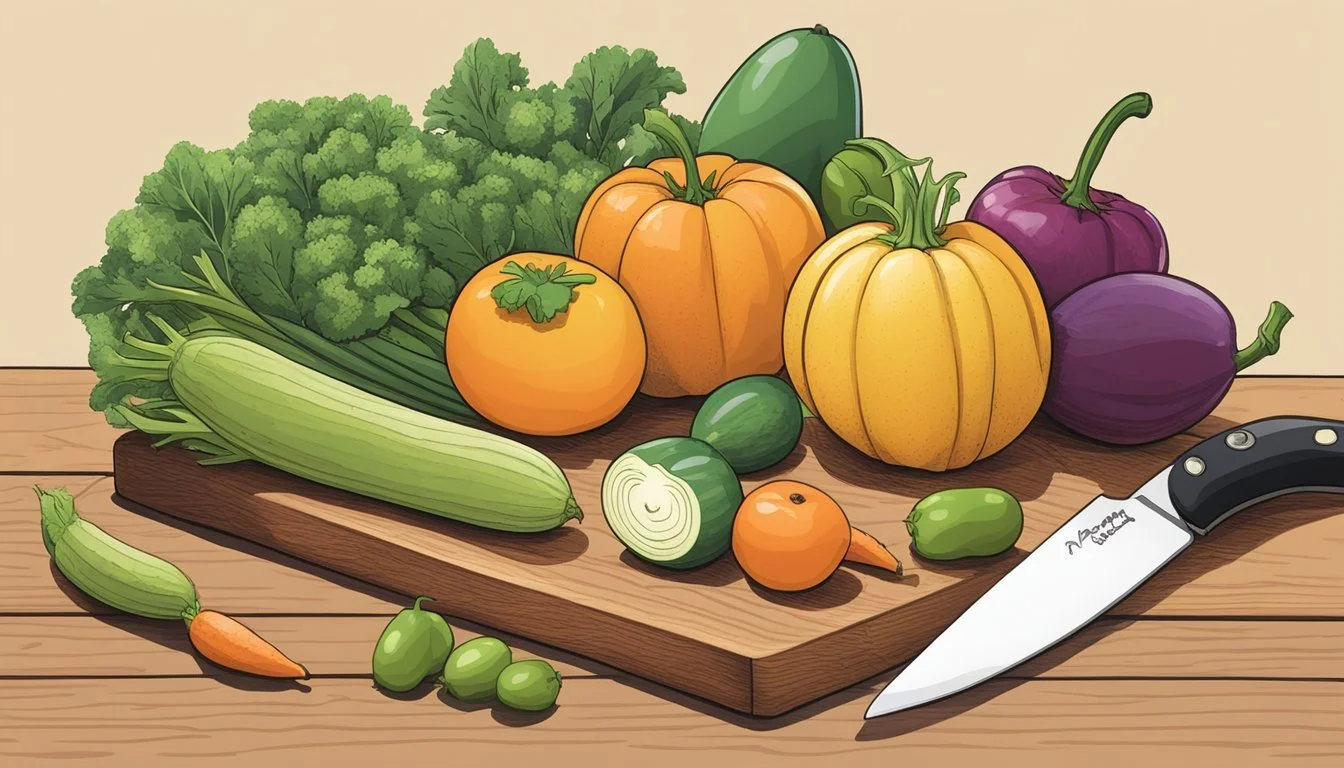Iowa Seasonal Fruit & Vegetables in September
Your Harvest Guide
This Article is Part of our Iowa Seasonal Fruit & Veg Calendar
Iowa's agricultural heritage flourishes with the turn of each season, offering an array of fresh produce that peaks in quality and flavor during specific periods of the year. September marks a transitional month where the warmth of summer meets the crisp onset of fall, presenting a unique and bountiful harvest. The lands yield a combination of late-summer fruits along with the first of autumn's vegetable offerings.
In this Midwestern state, September's harvest is particularly rich, giving consumers access to an assortment of fresh, locally-grown fruits and vegetables. Among the fruits, apples ripen on the trees, offering a range of varieties from tart to sweet, perfect for both eating fresh and baking. Pears also reach their peak, providing a juicy option for snacking and canning.
On the vegetable side, the cooler temperatures allow for the emergence of crops like cauliflower and bell peppers. Iowa's fields become a palette of colorful produce ready for culinary exploration. These vegetables, along with others harvested in this month, are known for their enhanced flavor, having grown during a period of warm days and cool nights. The state's produce calendar ensures that consumers enjoy these foods at their optimum taste and nutritional value.
Benefits of Eating Seasonal Produce
Seasonal produce offers a myriad of advantages spanning nutrition, the environment, and the economy. In Iowa, September showcases an array of fruits and vegetables at their peak, providing optimal freshness and quality.
Nutritional Advantages
Eating seasonal fruits and vegetables from Iowa in September ensures consumers receive produce at its highest nutritional value. Produce like pumpkins and apples, common in this month, are loaded with vitamins and antioxidants when harvested in their prime. The concentration of nutrients like Vitamin C, fiber, and various phytochemicals is significantly higher in these items when they are freshly picked.
Environmental Benefits
Seasonal eating has a positive impact on the environment. It leads to reduced transportation distances for produce, which in turn lowers greenhouse gas emissions. When Iowans choose local, seasonal items, they support farming practices that are more in tune with the state’s natural cycles and are less reliant on artificial means of production.
Economic Impact
The local economy benefits when consumers purchase seasonal produce. It ensures money spent on fruits and vegetables circulates within the state, bolstering Iowa’s economic health. Local farmers gain direct support from the community, which can lead to more sustainable business operations and the preservation of agricultural jobs within the region.
September's Seasonal Fruits
In September, Iowa's harvest calendar showcases a bounty of fresh fruits, with an emphasis on luscious berries and a variety of tree fruits reaching their peak ripeness.
Berries and Small Fruits
During this month, raspberries and blackberries (how long do blackberries last?) are among the small fruits that provide Iowans with fresh, juicy options. They are commonly utilized for jellies, desserts, or simply enjoyed fresh.
Raspberries: Generally available, these fruits are ideal for picking and eating straight from the bush.
Blackberries: This robust fruit is at the end of its peak season, offering a sweet and tart flavor profile.
Tree Fruits
September in Iowa is especially significant for tree fruits such as apples, pears, and plums.
Apples: A variety of apples are harvested, each with its distinct taste, from tart to sweet.
Honeycrisp: Known for its sweet flavor.
Red Delicious: A classic, with mild and sweet qualities.
Pears: This is the prime time for pears, with their soft, buttery texture and delicate sweetness.
Plums: The plump, juicy fruit is often found in markets and is perfect for making preserves or baked goods.
September's Seasonal Vegetables
In September, Iowa's fertile soils yield a robust variety of vegetables ready for harvest. These include an array of root vegetables, a diversity of squashes and gourds, along with fresh, crisp leafy greens and salad ingredients. The cooler temperatures this time of year enhance the flavor and texture of these seasonal offerings.
Root Vegetables
Sweet Potatoes: They come into season, offering their rich, sweet flavor and versatility in numerous dishes.
Carrots: Crunchy and sweet, these are ideal for both raw and cooked preparations.
Onions: A foundational vegetable, they offer a range of flavors from sharp to sweet.
Radishes: These provide a spicy kick to salads and side dishes.
Squashes and Gourds
Squash: Varieties like acorn and butternut are abundant, perfect for roasting or soups.
Pumpkins: Beyond decoration, they offer flavorful flesh for pies, soups, and roasted seeds.
Leafy Greens and Salads
Kale: This hearty green is at its peak, ready for salads, chips, or sautéing.
Lettuce: Varieties like romaine and leaf lettuce are crisp and perfect for salads.
Greens: Collards and mustards can be harvested now, ideal for cooking down or adding to dishes for a nutritional boost.
Preparing and Storing Fresh Produce
When handling September's bounty of fresh fruits and vegetables in Iowa, it's essential to ensure proper cleaning, storage, and preservation techniques for maximum freshness and longevity.
Cleaning and Preparation
One must carefully clean all produce to remove any dirt or residues. It is best to rinse fruits and vegetables under cold running water before consumption or storage. For items with thicker skins, using a produce brush can help eliminate surface contaminants. Drying with a clean cloth or a paper towel is recommended to prevent spoilage.
Storage Recommendations
Proper storage is crucial to maintain the nutritional value and extend the shelf life of fresh produce. Most vegetables, including leafy greens, should be stored in the fridge in a crisper drawer to retain moisture and crispness. Fruits like apples should be kept cool and can be placed in the fridge or a cool, dark place. Utilizing airtight containers can further protect produce from moisture and contaminants.
Vegetable Storage:
Leafy greens: Fridge, loosely wrapped in a damp paper towel.
Root vegetables: Cool, dark place; remove tops to prevent moisture loss.
Fruit Storage:
Apples: Fridge or cool, dark place.
Stone fruits: Ripen on the counter, then fridge to prolong freshness.
Preservation Techniques
For long-term storage, consider freezing, canning, jam making, or pickling. Freezing is suitable for most fruits and some vegetables after they're blanched. This retains the produce's nutritional value, typically high in fiber, for later use. Canning is a method that can be used for fruits, vegetables, and making jams, ensuring that food is preserved without the need for cold storage. Pickling not only extends shelf life but also imparts a unique flavor.
Cooking and Recipe Ideas
The versatility of Iowa's September produce can be showcased in numerous dishes spanning from light starters to comforting desserts. Chefs and home cooks alike take advantage of the peak freshness during this season to bring out the natural flavors in various recipes.
Salads and Starters
In composing Salads, one can blend the crisp textures and flavors of September fruits like apples with darker, leafier greens such as kale for a refreshing start to any meal. A classic Salad might feature roasted butternut squash (how long does butternut squash last?) paired with tart apples, walnuts, and a vinaigrette dressing. For Starters, chefs may offer a warming Soup that integrates roasted tomatoes and carrots, enhanced with fresh herbs like basil.
Roasted Beet Salad:
Sliced roasted beets (how long do beets last?), arugula, apples, goat cheese, balsamic reduction
Hearty Carrot Soup:
Blended carrots, onions, garlic, vegetable broth, thyme
Main Dishes and Sides
Moving on to Main Dishes and Sides, roasted and fried methods prevail. A noteworthy dish might include Stuffed Peppers filled with a mix of September harvest vegetables like corn and tomatoes, topped with a savory cheese. Iowa's abundant potatoes serve as an excellent base for Fried or Roasted side dishes, such as herbed potato wedges or a creamy potato gratin.
Autumn Stuffed Peppers:
Bell peppers, quinoa, black beans (how long do black beans last?), corn, shredded cheese
Herbed Potato Wedges:
Potato wedges, olive oil, rosemary, thyme, sea salt (how long does sea salt last?)
Desserts and Snacks
For Desserts, fresh fruits are a highlight in September. Apple or pear Cakes celebrate the season, where the fruit can be baked into cinnamon-spiced batters or used as toppings. Hand-held Snacks like turnovers and fruit bars offer a portable way to enjoy sweet, local fruits.
Apple Cinnamon Cake:
Diced apples, cinnamon, sugar, flour, eggs, baking powder
Pear Turnovers:
Puff pastry, sliced pears, brown sugar, nutmeg (how long does nutmeg last?), egg wash
Iowan cooks leverage the season's bounty to create dishes with depth and flavor, from the first course to the last.
Shopping Tips for Seasonal Selections
In September in Iowa, consumers are offered a bounty of fruits and vegetables at their peak. Understanding how to select the best produce at markets and how ripeness and size affect taste and use is crucial for making the most of seasonal offerings.
Finding Quality Produce
When shopping at a market, look for fruits and vegetables that are firm and heavy for their size, as this often indicates they are juicier and packed with flavor. The surface should be shiny and smooth, without bruises or blemishes, which can signal that the produce is fresh and handled with care.
Apples: Should be firm with a rich color, and the stem should be intact.
Sweet Corn: The husks should be green and wrapped tightly around the cob, with silky tassels that are slightly sticky.
Tomatoes: Must have a bright color and yield slightly to the touch.
Understanding Ripeness and Size
The ripeness of fruit and vegetables can greatly affect their taste and texture. Typically, smaller fruits such as berries are sweeter when they are ripe, while larger fruits can be more tart and less juicy. The stem of produce like apples can also indicate freshness; a firmly attached stem suggests the apple was recently picked.
Melons: Heaviness indicates juiciness, and a hollow sound when tapped suggests ripeness.
Zucchini: Smaller zucchini tend to be more crisp, whereas larger ones are better suited for recipes that require cooking down, like stews.
Iowa's Seasonal Produce Calendar
September in Iowa marks a significant change in the agricultural calendar as the state transitions from the bountiful offerings of summer to the harvests that signal the approach of fall. This period is critical for both farmers and consumers, as they begin to switch their focus from the waning warm-weather crops to those that thrive in the cooler temperatures.
Summer to Fall Transition
During September, Iowa's farms are busy harvesting both summer and early fall crops. They offer a variety of produce that capture the essence of this transition period.
Vegetables:
Tomatoes (continue from summer)
Sweet Corn (late-season varieties)
Zucchini
Cucumbers
Peppers
Fruits:
Apples (early varieties such as Jonathan and Gala)
Melons (tailing off as the month progresses)
Plums
These items are readily available at farmers' markets, with their presence signaling the overlap of summer abundance and fall's first arrivals.
Anticipating Winter Offerings
As the warmth of the Iowa summers makes way for the coolness of fall and the subsequent winter, farmers prepare for the late-season and storage crops that will provide sustenance through the colder months.
Vegetables:
Winter Squash (acorn, butternut, and spaghetti begin to appear)
Pumpkins (just starting, becoming more abundant toward end of the month)
Potatoes
Carrots
Beets
These vegetables not only thrive in the cooler weather but are also capable of being stored well into winter, ensuring a steady supply of local produce.
In September, Iowans are privy to a wide-ranging palette of flavors and nutritional options thanks to the diligent efforts of the state's agricultural community, characterized by the careful planning of planting and harvesting schedules.









